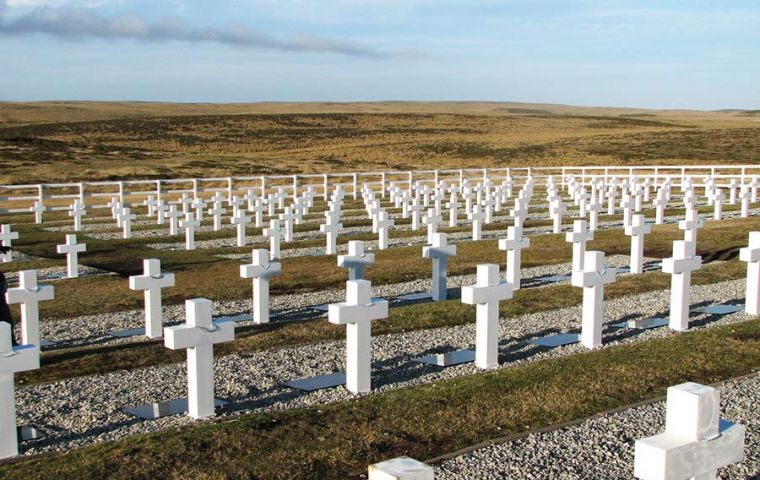MercoPress. South Atlantic News Agency
Number of Argentine soldiers buried in the Falklands and identified now total 110
 The Argentine military cemetery close Darwin
The Argentine military cemetery close Darwin The number of Argentine unknown soldiers buried in the Falkland Islands has fallen by three as those identified and with full names now total 110 out of the original 121/122 remains buried inat the Argentine military cemetery close Darwin.
This was announced by the Argentine Secretary of Human Rights Claudio Avruj, who this week visited the relatives of the newly identified remains in the province of Corrientes.
The DNA identification process is part of the humanitarian project agreed by UK and Argentina with the consent of the Falkland Islands government and has been ongoing for several years with great success for the families involved.
The three soldiers from Corrientes, Ramon Cirilo Blanco, Daniel Omar Luque and Mario Gómez were all less than 20 years old and were recruited to be sent to the South Atlantic. Blanco was a member of the 12th Mechanized Infantry Regiment and was stationed at Darwin where he died on 23 May 1982. Apparently Blanco was semi illiterate.
Mario Gomez became a member of the 4th Mechanized Infantry Regiment and died on 11 June 1982, while Luque, from the 12th Mechanized Infantry Regiment fell in combat in Goose Green on 23 May 1982.
Secretary Avruj said the trip to Corrientes, and the day before to Resistencia in the province of Chaco where he met the relatives of the 107th identified soldier, Ruben Horacio Gomez, was “a recognition to the two provinces which provided most of the heroes to defend the motherland in the Malvinas war”
“This humanitarian effort helps us to promote dialogue, and get closer to these forgotten families and help them put to rest their anxiety, pain and grief, knowing where their beloved ones now are buried and clearly identified” added Avruj.
“For 36 years nobody responded to these families about their beloved ones that one day left to defend the motherland. With this humanitarian plan we are helping the families to overcome so many years of obscurity and official indifference”.
The provinces of Corrientes and Chaco with their semi tropical climate are among the poorest or rather less developed in Argentina and with significant percentages of indigenous population.




Top Comments
Disclaimer & comment rulesCommenting for this story is now closed.
If you have a Facebook account, become a fan and comment on our Facebook Page!